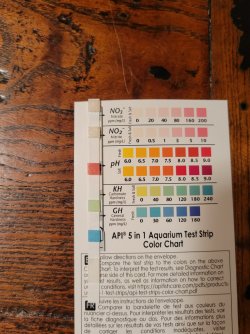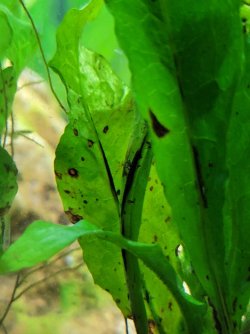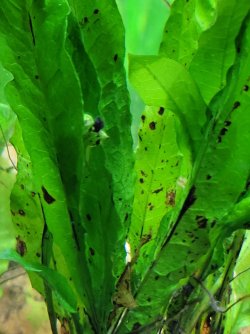I'm struggling to keep aquarium plants healthy green and alive! What am I'm doing wrong? I use API root tabs and leaf zone. Some Aquatic plants turn spotty black, some turn brown, and some turned to soft mush breaking apart such as my MADAGASCAR LACE. I use a Fluval plant light that is turned on low light for 10hrs a day. Here is a picture of my current fern I'm struggling with. Advice?
I'll comment on the Java Fern and then in general on the issues.
Black spots that are relatively uniform in size and in rows on the underside of the fronds [= leaves] would be spores for new adventitious plants. But what we see here is not that; difficult to see accurately but some of the black spots appear to be raised up from the frond, which suggests black brush algae which is frequently seen on this plant if it is permanently under bright lighting (floating plants usually solve this). Irregular black blotches are likely due to nutrient issues.
Which brings me to the general issues on all your plants you mentioned. The light/nutrient balance. Can you provide any more data on the lighting? "Low" if it really is low would affect some of the other plants that need brighter light, depending what the "low" is providing in intensity. There is also the spectrum, do you know the Kelvin? Duration cannot make up for lighting that is not of sufficient intensity to drive photosynthesis, and this is specific for each plant species though we obviously can find some middle ground for some plant groupings. But if the "low" really is not bright enough for say the
Nymphaea lotus I think I see in the photo, leaving that light on fgor ten hours will have no more benefit than five hours. And there would seem to be insufficient nutrients to balance the light so I would suggest reducing the time to maybe 7 or 8 hours (on a timer is best), along with some other changes.
This brings us to nutrients. A major problem is certainly the API Leaf Zone. This is only iron and potassium, so the other 12 or so essential nutrients need to be provided somehow, and the fish load alone is unlikely to do this, so a comprehensive supplement will be better. The other thing is too much iron is deadly, I have known this alone to kill plants. A comprehensive product like
Flourish Comprehensive Supplement, or Brightwell Aquatics'
FlorinMulti, will benefit. This is a low-tech or natural method tank, not high-tech, so either of these products
will provide the full range of nutrients [except carbon, hydrogen and oxygen which are naturally present] the plants need, and each is in proportion so you are not risking over-dosing. Too much of a nutrient can cause plants to shut down assimilation of another nutrient, and some nutrients beyond what is needed can negatively impact plants. Nitrogen is included in both of these but in limited quantity because most people have fish and nitrogen is not missing; plants use the ammonia/ammonium as their preferred nitrogen source, and that is not likely to be lacking. Calcium and magnesium are also minimal in these products, because many people have sufficient in their source water, so knowing your GH is important.
The API root tabs have had not-so-good reviews from some in past threads. Their website will not disclose the ingredients, "trade secret" they say, which to me says forget this product, it is very likely not worth it. I know from using them for over a decade now that Flourish Tabs produce incredible results in substrate-rooted plants like swords, Nymphaea, aponogeton, etc.
May have more when I know the requested info (light data, and GH).





